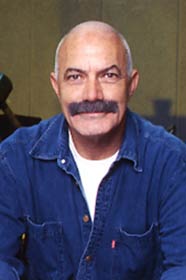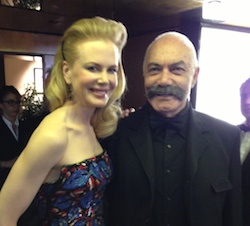




“The Exorcism of Emily Rose” combines two of Hollywood’s most popular genres, the courtroom drama and the horror flick, resulting in a middling, semi-effective movie, considerably elevated by Laura Linney’s strong performance.
The 1973 “Exorcist” notwithstanding, there have not been many films about exorcism of late, and this one may benefit from that
Since the movie is “based on a true story,” it raises the questions of intent and approach. How are we supposed to take the story. Seriously? Semi-seriously? Just another exploitative movie about exorcism.
Then, there’s the interrelated issue of to what extent the text is too pretentious, aiming high to the realm of Kant and other philosophers in its concerns with reason and doubt, and secular- rational thought versus religious-mythic beliefs that that can’t be proven scientifically.
On its own terms, though, “Exorcism of Emily Rose” is quite enjoyable as an intelligent court trial drama, punctuated by flashbacks that recreate the tormented life of its titular heroine. It certainly help that director Scott Derrickson has gathered an impressive cast, headed by the always reliable Laura Linney, Tom Wilkinson, and Campbell Scott, not to mention Jennifer Carpenter, who plays the tortured Emily with credibility.
That said, courtroom dramas are usually static and verbose, and this one is no exception. That the special effects are rather simple by today’s standards may prove to be a deterrent for young audiences who usually embrace the horror genre.
Even so, those who predicted gloom and doom to the horror genre, in the wake of such box-office failures as Romero’s “Land of the Dead,” “House of Wax,” and other flicks this summer, should take note. There’s still blood and juice in the old narrative structures of horror and courtroom melodramas.
The “based on a true story,” and the whole issue of accuracy and authentication should be taken with skepticism. A very loose adaptation of the case of a German teenager in the 1970s, the story concerns the prosecution of a priest for his “negligent” role in her exorcism and eventual death. The priests and parents of Annelise were found guilty of manslaughter and negligence for which they served time in prison. A note after the film informs that Annelise’s gravesite is now a “shrine,” visited by people who consider her saint for enduring demonic possession as a sacrifice.
In “An Exorcist Tells His Story” by Rome’s chief exorcist, Gabriele Amorth Fr., he relates the experiences of his ministry doing battle with Satan to relieve the suffering of people in the grip of evil. Fr. Amorth mentions the exorcism of Annelise Michel of Kilingenberg, who died in 1976, at the age of 21, after a series of exorcisms precipitated by her possession. As noted, the two exorcists involved, along with Annelise’s parents, underwent a trial.
There have been several books about this case, each with its own angle and different conclusions. One of the better-researched books is “Annelise Michel” by Kasper Bullinger. According to Fr. Amorth, Bullinger showed that both the bishop who had authorized the exorcisms and the two priests who executed them had behaved with propriety. It’s believed that Annelise’s controversial case led to the reluctance of many priests to engage in exorcism.
Anneliese Michel’s exorcism serves as the basis for the new horror movie. At first sight, Emily Rose (Carpenter), a young devout Catholic, is an unlikely candidate for demonic possession. However, after leaving for college, demonic forces invade her body and start raising havoc. She’s depicted as an average girl who suddenly finds herself “possessed” by dark forces that bend her out of shape at three in the morning, the witching hour of evil.
Emily returns home, and scientists diagnose her condition as “psychotic-epileptic disorder,” prescribing drugs that don’t help her condition. Fleeing one night to a church, Emily comes under the sway of Father Richard Moore, who tells her that the problem is spiritual, not physical.
With her family’s consent, Moore begins the ritual of exorcism on Halloween Night! However, his execution of an official Catholic exorcism pushes too far Emily’s already weakened body, resulting in death. Upon examining Emily’s body, the medical doctor refuses to certify Emily’s death as natural cause, and Father Moore is arrested.
The diocese hires ambitious lawyer Erin Bruner (Linney), a junior partner at a law firm run by Karl Gunderson (Colm Feore). She’s a fast-rising star after getting a high-profile murderer off the hook. When Gunderson asks her to take on the case of Father Moore (Tom Wilkinson, in top form), she accepts, based on the promise to be made a senior partner, if she wins.
To protect itself from accusations of antireligious bias, the district attorney’s office decides to field assistant D.A. Ethan Thomas (a likable Campbell Scott), a proper, devout churchgoer. The agnostic Erin is contrasted with prosecutor Thomas, a religious man who teaches Sunday school and sings in the church choir.
At first, Erin has hard time convincing the jury of a case of “demonic possession.” Moreover, soon, she herself begins to feel harassed by elemental dark forces. For help, Erin hires an anthropologist (Shoreh Agdashloo), who’s familiar with cases of possession in other cultures. Time is running out: Just as Bruner is about to lose the case, the medical doctor comes forward, willing to testify, despite fears. As the trial continues, Erin begins to experience nighttime scares, and her agnosticism starts to crumble. She constructs a defense argument that hinges on spiritual possession being accepted as a rational phenomenon.
Unlike other exorcism films, this one seems to be based on deeper knowledge, hence the juxtaposition of epilepsy and possession, which is important since the tortured Emily was not violent to her family.
The screenwriters, helmer Derrickson and Paul Harris Boardman, have written a taut script that explicates all we need to know in the first reel. Most of the film intercuts courtroom proceedings with flashbacks to Emily’s story, revealed through the testimony of various witnesses.
The arguments unfold in a clear way. As if to make sure that the audience understands what’s going on, Erin repeatedly says, “By that, you mean….” In “Rear Window,” Hitchcock used the same device, when Grace Kelly periodically says to Jimmy Stewart, “Tell me everything you know so far,” so that we the viewers know where we are in the story.
For the most part, the filmmakers avoid exposition of unnecessary background information, or personal scenes with family and friends, which makes the text tighter. Occasionally, though, the script imposes on its contemporary characters archaic and movieish lingo, like “the forces of darkness.”
But the juxtaposition of the yarn’s legal matters with the horror elements not only lands the picture tension but also makes the viewing more interesting. “Exorcism of Emily Rose” presents in an intelligent way the debate between science and faith, and its effect on nonbelievers like Erin, and it doesn’t fail to provide the shocks and thrills expected of horror fare.
Derrickson, who previously helmed “Hellraiser V: Inferno,” handles the courtroom scenes in a straightforward manner that follows the genre’s conventions. Though concentrating on Emily’s physical rather than psychological possession, Derrickson doesn’t go for cheap thrills.
As director, he doesn’t resort to many CGI images, which have become a norm in contempo horror yarns. Instead, the horror comes from old-fashioned devices, mostly elements of mise-en-scene, such as shades of lighting, color palette, the design.
The ever likeable and versatile Linney carries the picture, making the most of a routine role. Her concluding court speech, though long and verbose, is particularly impressive.










